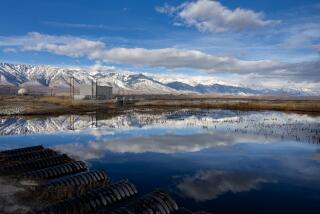Put a knot in L.A.’s hose
MAYOR Antonio Villaraigosa has asked Los Angeles to reduce water consumption by one-tenth.
Asked? A tenth? He should have demanded, and he should have required a 25% cut.
The mayor’s one-tenth, if it is achieved, will amount to a fraction of the crucial emergency reserves that the Metropolitan Water District estimates will be depleted by its 18 million customers as Southern California rides out a record dry year. There is little reason to be confident that we will be able to make up the deficit anytime soon.
With ghastly symmetry, the three sources supplying almost 60% of Southern California’s water are in crisis.
The Colorado River is over-allocated, meaning there are more yearly claims to the water than there is snowmelt flowing into the river. Deliveries to Southern California urban users have dropped by half in the last five years.
Supplies from the eastern Sierra Nevada also have dropped by half, as the Los Angeles Department of Water and Power attempts to remedy dustbowl conditions in Owens Valley caused by its withdrawals.
Up north, a disappointing snow season and efforts to protect migrating fish in the Sacramento River delta mean that the State Water Project expects to cut normal deliveries to Southern California by 40% this year.
Without meaningful conservation, we’ll dip deep into the much-vaunted reserves stored in Diamond Valley Lake near Hemet, the jewel of the MWD’s emergency storage system. The awful irony is that if we had been keeping pace with other conservation programs in the West, we not only would be preserving our disaster fund, we’d be topping it off while still protecting mountain lakes and river deltas.
Our waste is so chronic and vast in Southern California that it amounts to a fresh water supply. The MWD and its member agencies, such as the DWP, provide nearly 4.4 million acre-feet of water to the region’s cities. Roughly half that is used outdoors, where more than a million acre-feet a year — enough to meet the needs of 2 million families — is wasted by over-watering with hoses and badly programmed sprinklers and by car washing and driveway hose-downs. In our gardens, the most common cause of plant death is over-watering; an estimated 100 million gallons of runoff flows through L.A. storm drains into the Pacific every day.
Instead of making a serious bid to capture this outdoor waste, after the drought of the late 1980s and early ‘90s, the MWD instituted industrial water-recycling projects and ground-water recovery programs and encouraged indoor conservation in the form of low-flush toilets and rebates for front-loading washing machines. Sixteen percent of the water we use now comes from recaptured water. But only 2% of that comes from what’s called “active conservation” — you and I watering less.
It wasn’t until 2002, with drought settling in the Colorado River basin, that the MWD launched BeWaterWise, a campaign aimed at reducing “active” home-water waste. But BeWaterWise set no hard-and-fast goals, and the investment in public outreach over the last five years reached only about $10 million. Even with a top-up this month of $6.3 million for advertising, this is chump change.
Southern California continued to waste water after 2002 because it could afford to — it still had water in the system. Nothing sums up the lack of commitment better than the lawns outside some DWP substations. Meanwhile, Arizona, Colorado, Nevada and New Mexico had no option but to react fast and conclusively. Nevada’s successes in particular highlight our blunder.
In 2002, Las Vegas stole the BeWaterWise idea and aced it. Instead of lawn around the Southern Nevada Water Authority’s offices, there’s agave and desert willows. The authority offered $1, then $2 per square foot to homeowners to replace grass with more suitable planting. Municipal governments pitched in, restricting lawns to backyards in new developments. Homeowners whose sprinklers create runoff now face the kinds of fines that L.A. reserves for parking tickets, and there are ordinances restricting watering times.
Southern Nevada acted while we tarried because it was in the kind of crisis then that we are in now. It hit the ceiling of its Colorado River allocation and had only dwindling local water sources as backup. It could not afford an elective program, and it did not shy from a draconian solution.
The questions before Southern Californians now are: Can we afford for water security to be elective? Can we continue to drain the two most important river deltas in the West and leave dustbowls in the mountain ranges while we poison the Pacific with runoff?
The answers have to be no and no. The mayor of the largest city in the Southland shouldn’t be asking Angelenos to conserve but should be moving to mandate it. And he should start at City Hall, where the lawn is so over-watered that mushrooms could grow.
More to Read
Sign up for Essential California
The most important California stories and recommendations in your inbox every morning.
You may occasionally receive promotional content from the Los Angeles Times.










